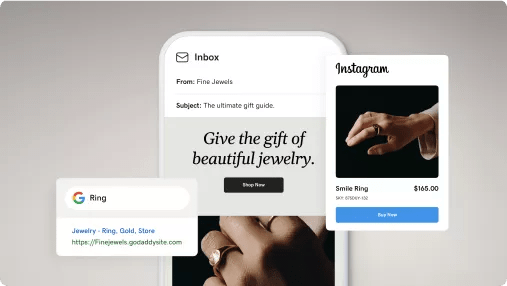Raise Your Brand with The Ad Firm Web Design: Where Innovation Fulfills Capability
Raise Your Brand with The Ad Firm Web Design: Where Innovation Fulfills Capability
Blog Article
Enhance Individual Experience and Drive Website Traffic With Responsive Web Design
In today's digital landscape, where users are accessing websites from a wide variety of gadgets, receptive website design has ended up being more vital than ever before. With its ability to adjust and flawlessly get used to different screen sizes, receptive layout not just enhances user experience but additionally drives traffic to your web site. However why is this style strategy so vital? Exactly how does it enhance individual engagement and increase website traffic? In this conversation, we will certainly check out the crucial elements of effective responsive layout, explore the finest practices for its implementation, and reveal the tricks to improving individual experience while driving even more web traffic to your site.
Why Receptive Internet Style Matters
Responsive internet design is an important aspect of modern web growth due to its capacity to guarantee ideal customer experience throughout numerous devices and screen sizes. With the expansion of smart devices, tablets, and other mobile tools, it has actually come to be important for websites to adapt and give seamless performance no matter of the device being utilized.
The key reason responsive internet style issues is that it allows individuals to have a pleasurable and regular browsing experience, no matter the gadget they are making use of. A receptive website instantly adjusts its content, layout, and design components to fit the display size and resolution of the gadget, guaranteeing that users can easily navigate and connect with the web site without any kind of inconvenience or stress.
Furthermore, responsive website design also plays a significant role in search engine optimization (SEARCH ENGINE OPTIMIZATION) Internet search engine, such as Google, focus on web sites that are mobile-friendly and receptive in their search engine result. By integrating receptive style principles, web sites can enhance their exposure and position, bring about raised natural web traffic and prospective clients.

Boosting Individual Interaction Via Responsive Design
Maximizing customer engagement is a crucial objective of receptive design, as it makes certain that users can quickly accessibility and connect with site material on any type of tool. With the enhancing usage of tablets and mobile phones, it is critical for websites to adapt to different screen sizes and resolutions. Responsive style allows internet sites to immediately change their design and material to give a smooth customer experience throughout devices.
One of the primary means responsive style boosts customer involvement is by minimizing lots times. With a receptive web site, users do not need to await different mobile versions to tons, leading to quicker accessibility to web content. This enhanced speed causes greater customer fulfillment and motivates them to spend more time on the website.
Furthermore, responsive layout improves user engagement by boosting navigating and customer interface (The Ad Firm). When an internet site is developed responsively, buttons and food selections are maximized for touch interactions, making it simpler for customers to interact and navigate with the site on their mobile gadgets. This easy to use and intuitive experience keeps customers involved and urges them to discover even more of the web site
Moreover, responsive style enables better content exposure and readability. By adapting the format and font sizes to different tools, receptive websites ensure that users can easily comprehend the web content and check out. This improves user interaction by minimizing the demand for zooming or scrolling to review the message.
Raising Web Site Website Traffic With Responsive Website Design
With the growing popularity of mobile devices, having an internet site that is responsive to different display sizes and resolutions is important for driving increased traffic. In today's electronic landscape, customers are accessing websites from a variety of devices such as smart devices, tablets, and desktop. Each of these devices has various screen sizes and resolutions, and if your website is not created to adjust to these variants, it can lead to an inadequate customer experience and a loss of prospective web traffic.
Responsive website design makes certain that your web site looks and functions optimally throughout all tools. By using adaptable grids, liquid photos, and media questions, responsive style enables your website to instantly change its design, material, and navigation to fit any kind of display size. This implies that individuals will have a seamless browsing experience despite whether they are using a huge desktop computer or a small smartphone computer system.
Secret Aspects of Effective Receptive Layout
Reliable responsive style integrates several essential components that make certain a smooth user experience across different gadgets. One of these components is adaptable grids and formats. By making use of loved one devices like portions as opposed to repaired units like pixels, designers can produce layouts that website design australia scale and adjust to fit various screen dimensions. This allows material to be shown in a readable and visually attractive manner on any type of tool.
Another vital aspect is media queries. These enable designers to use various styles and designs based on the characteristics of imp source the user's tool, such as screen dimension and alignment. By utilizing media inquiries, designers can enhance the presentation of content for each and every device, ensuring that it is quickly obtainable and readable.
Receptive pictures are additionally critical in efficient receptive layout. Photos that are too large can decrease web page lots times on mobile gadgets, while pictures that are also small may appear pixelated on larger displays. By using methods such as responsive picture resizing and careless loading, designers can make sure that images are suitably sized and enhanced for every tool.
Finally, efficient responsive design involves a mobile-first approach. This indicates creating and focusing on material for mobile devices first, and after that boosting the style and broadening for bigger displays. This technique guarantees that the most vital material is quickly available on smaller screens, while still supplying an abundant experience on larger devices.
Best Practices for Implementing Responsive Internet Layout
Executing receptive website design calls for mindful consideration of different best practices to guarantee an ideal user experience across various devices. Below are some vital best techniques to follow when applying receptive internet design.
First of all, it is vital to focus on mobile users. With the boosting prominence of smart phones, designing for mobile-first has actually become crucial. Begin deliberately for smaller screens and then progressively boost the design for bigger screens.

An additional crucial best the original source practice is to optimize images for different screen resolutions. Large photos can reduce down the packing time of your internet site, especially on mobile phones with slower connections. Use receptive images that can be resized based upon the tool's screen resolution to enhance efficiency.
In addition, test your internet site on various devices and screen dimensions to make certain a smooth and constant experience. There are various screening devices available that can assist you determine any problems and make required modifications.
Lastly, prioritize usability and ease of access. Make sure that your website is simple to browse, with clear and concise web content. Ensure that your website is obtainable to people with specials needs and complies with ease of access guidelines.
Conclusion
In final thought, receptive internet layout plays an essential function in enhancing user experience and driving website traffic to websites. By taking on receptive design concepts, internet sites can make certain ideal watching experiences throughout different gadgets, leading to enhanced individual interaction.
Enhancing customer involvement is a vital goal of receptive design, as it makes certain that customers can easily gain access to and engage with website content on any device. Responsive design enables sites to instantly change their design and material to offer a smooth individual experience throughout devices.
Furthermore, receptive layout enhances user engagement by boosting navigating and individual interface.Receptive photos are likewise critical in efficient receptive layout. By embracing receptive style principles, websites can guarantee optimum viewing experiences throughout different gadgets, leading to increased customer engagement.
Report this page